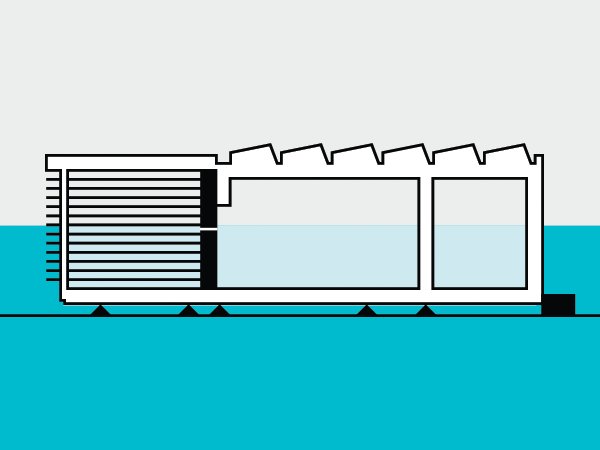

For us, storm resistance is not just an afterthought. It is not something added to our building and called “resilient”. Storm proofing is not adding plywood over windows and hoping a quick fix can save your home. SURE HOUSE’s notion of storm proofing begins as an overall contemporary idea, which works its way down to the smaller details. We’re looking at prior coastal construction methods as precedents in order to build toward the future by identifying what has been successful, and what is prone to storm damage.
There are a few categories that SURE HOUSE has broken a typical coastal home’s construction methods into: Exterior Envelope, Floor/Structural Systems, Finished Interior, Thermal Barriers, and Electrical.
Looking at the Exterior Envelope of a typical coastal home, we realized there were many issues with water proofing. Typical methods consist of using plywood sheathing, felt paper, and an exterior siding. This allows for water to penetrate the envelope and cause damage to the home. SURE HOUSE uses an innovative composite sheathing which wraps on the underside of the home up to the designated FEMA Flood elevation level. In the case of SURE HOUSE, this house is rated to withstand up to a FEMA 6/7 Zone (+/- 6 feet of water). SURE HOUSE also uses a rainscreen system on its façade. A rainscreen is where the siding stands off from the moisture-resistant surface of an air barrier applied to the sheathing to allow drainage and evaporation.

The structural system floor system of a typical coastal home is also prone to damage. For example, you are a home owner of a small bungalow on the Jersey Shore. A storm hits, and you have received a substantial amount of water in your home. You decide to pump the water out of your home. Problem solved, right? Wrong…A typical floor structure of either TGI Wood Joists or Standard Dimensional Lumber wood beams are solid. Therefore, water and moisture does not air out, leading to mold, or even worse structural damage. SURE HOUSE’s solution for this is to use an open web wooden truss floor system. If there is any sort of water penetration into the home, the floor system has the ability to allow for airflow which minimizes the chance of long term rotting, mold damage, and issues to the structural integrity of the home.
The finished interior of a typical coastal home would consist of carpet/wood flooring, and sheetrock walls. If these become wet, they have the potential to hold moisture and create mold. Two unique floor finishes are incorporated into SURE HOUSE to allow for water contact. The primary flooring in the living room is a panelized cork board, which is extremely durable and water resistant, and the second is a vinyl tile system, which is also extremely water resistant, as well as made from recycled materials. Both of these, along with SURE HOUSE’s “beachy wooden box interior” allow for minimal water/moisture damage.


Thermal barriers are extremely important when it comes to energy efficiency of a home. A typically coastal home is most likely using a fiberglass insulation as its primary thermal barrier. If these barriers become compromised due to flooding, they might not only need to be replaced, but you will have to gut your interior walls in the process. SURE HOUSE’s Passive House Standard is quite simple, keep air leaks out. The benefit of this is we are able to tape all exposed joints, gaps, and any other area susceptible to air infiltration, and in the process we automatically are able to reduce the smaller nooks water can leak into. SURE HOUSE also uses a rigid insulation on the interior and exterior of the house to optimize R-Values, as well as use an insulation that does not absorb or degrade when in contact with water.
The electrical in a typical coastal home can be all over the place. Wires and receptacles running along the floor. HVAC, water tanks, and breaker boxes running at levels that may be susceptible to water damage. SURE HOUSE takes this into account by acknowledging our FEMA AE Flood Zone. No Receptacle, or wire is below the AE Zone. All electrical devices use this flood zone as a marker, so if there is water infiltration into the home it is definitely out of harm’s way.
By looking at these prior construction methods we have been able to identify what storm resistant techniques have been successful and which are prone to damage. By coming up with innovative storm resistant solutions to the construction methods of a contemporary coastal home, we hope SURE HOUSE can be used as a learning tool for future designers and builders in flood prone areas.

